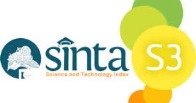Perceptions of Pre-Service Science Teachers in Nusantara Capital City About The Greenhouse Effect
(1) Mulawarman University
(2) Mulawarman University
(3) Mulawarman University
(*) Corresponding Author
Abstract
The Greenhouse Effect is essential in protecting the survival of living things on Earth. However, the system will crash if the Greenhouse Effect is excessive. The form of damage is global warming which can cause system changes to ecosystems on Earth. A group that can take a proactive role in this educational context is the student community. This study aims to provide an overview of preservice science teachers' perception of the Greenhouse Effect and understanding of the environment, especially in the Nusantara capital city. The research method used an exploratory study with a quantitative and qualitative approach. The data collection technique used a survey using a questionnaire instrument to students of Physics, Biology, Chemistry, and Geography Education at Mulawarman University. The questionnaire in this study used was developed by Boyes and Stanisstret (1993). The questionnaire consisted of 36 statements rated on a 3-point Likert scale. The statement was divided into three sections, each containing 12 statements, distributed using Google Forms. The results showed that preservice science teachers had many misperceptions and were still wrong in determining the cause-and-effect relationship of the greenhouse effect and solutions to reduce it.
Keywords
Full Text:
PDFReferences
Aksan, Z., & Celikler, D. (2013). Pre-service elementary teacher’s perceptions and opinions about greenhouse effect. Journal of Baltic Science Education, 12(2), 159–177.
Albergel, C., Calvet, J. C., Gibelin, A. L., Lafont, S., Roujean, J. L., Berne, C. (2010): Observed and modelled ecosystem respiration and gross primary production of a grassland in southwestern France. Biogeosciences 7(5): 1657-1668. https://doi.org/10.5194/bg-7-1657-2010
Boyes, E., & Stanisstreet, M. (1993). How do high school students perceive global climatic change: What are its manifestations? What are its origins? What corrective action can be taken? Journal of Science Education and Technology, 2(4), 541–557. https://doi.org/10.1007/BF00695323.
Bryce, T. G., & Day, S. P. (2013). Scepticism and doubt in science and science education: The complexity of global warming as a socio-scientific issue. Cultural Studies of Sciences Education, 9(3), 599–632.
Cardak, O., & Dikmenli, M. (2016). Student science teachers’ ideas about the degradation of ecosystems. International Education Studies, 9(3), 95–103.
Darçın, E. S., Bozkurt, O., Hamalosmanoğlu, M., & Köse, S. (2016). Determination of elementary students’ level of knowledge and misconceptions about greenhouse effect. International Journal of Environmental and Science Education.
Dewi, S. Z., & Ibrahim, T. (2019). Pentingnya pemahaman konsep untuk mengatasi miskonsepsi dalam materi belajar IPA di sekolah dasar. Jurnal Pendidikan UNIGA, 13(1), 130-136.
Etobro, B. A. (2020). Pre-service biology teachers’ perception of global warming, greenhouse effect and ozone layer depletion in Lagos state university. Global Journal of Educational Research, 19(1).
Fensham, P. J. (2014). Scepticism and trust: Two counterpoint essentials in science education for complex socio-scientific issues. Cultural Studies of Science Education, 9(3), 649–661.
Huang, S. K., Kuo, L., Chou, K. L. (2016): The applicability of marginal abatement cost approach: A comprehensive review. Journal of Cleaner Production. 127: 59-71. https://doi.org/10.1016/j.jclepro.2016.04.013.
Jafer, Y. J. (2020). Assessing Kuwaiti pre-service science teachers’ greenhouse effect perceptions and misconceptions. International Journal of Science and Mathematics Education, 18(4), 657-667. https://doi.org/10.1007/s10763-019-09992-1.
Kadiyala, A., Kommalapati, R., & Huque, Z. (2016). Quantification of the lifecycle greenhouse gas emissions from nuclear power generation systems. Energies, 9(11), 863.
Khalid, T. (2003). Pre-service high school teachers’ perceptions of three environmental phenomena. Environmental Education Research, 9(1), 35–50.
Lambert, J. L., & Bleicher, R. E. (2017). Argumentation as a strategy for increasing preservice teachers’ understanding of climate change, a key global socioscientific issue. International Journal of Education in Mathematics, Science and Technology, 5(2), 101-112.
Mayasari, Dian. (2022). Ibu Kota Negara Baru : Integrasi Infrastruktur dan Kelestarian Alam, diakses pada tanggal 15 Juni 2022 melalui https://kpbu.kemenkeu.go.id/read/1150-1404/umum/kajian-opini-publik/ibu-kota-negara-baru-integrasi-infrastruktur-dan-kelestarian-alam.
Oktyabrskiy, V. P. (2016). A new opinion of the greenhouse effect. St. Petersburg Polytechnical University Journal: Physics and Mathematics, 2(2), 124-126.
Pethica, J. (2010) Climate change: A summary of the science. London: The Royal Society Science Policy Centre, diakses pada tanggal 30 November 2022 melalui https://royalsociety.org/topics-policy/publications/2010/climate-change-summary-science/
Sulaiman, M. E., Setiawan, H., Jalil, M., Purwadi, F., Brata, A. W., & Jufda, A. S. (2020). Analisis Penyebab Banjir di Kota Samarinda. Jurnal Geografi Gea, 20(1), 39-43. https://doi.org/10.17509/gea.v20i1.22021
Tongwane, M., Mdlambuzi, T., Moeletsi, M., Tsubo, M., Mliswa, V., & Grootboom, L. (2016). Greenhouse gas emissions from different crop production and management practices in South Africa. Environmental Development, 19, 23-35.
Shepardson, D. P., Niyogi, D., Choi, S., & Charusombat, U. (2011). Students’ conceptions about the greenhouse effect, global warming, and climate change. Climatic Change, 104(3), 481-507.
Hutasoit, W. L. (2019). Analisa pemindahan ibukota negara. DEDIKASI: Jurnal Ilmiah Sosial, Hukum, Budaya, 39(2), 108-128.
Article Metrics
Abstract view : 391 timesPDF - 74 times
DOI: https://doi.org/10.26714/jps.11.1.2023.9-20
Refbacks
- There are currently no refbacks.
Copyright (c) 2023 JURNAL PENDIDIKAN SAINS UNIVERSITAS MUHAMMADIYAH SEMARANG

This work is licensed under a Creative Commons Attribution 4.0 International License.
EXECUTIVE OFFICE
JURNAL PENDIDIKAN SAINS UNIVERSITAS MUHAMMADIYAH SEMARANG
DEPARTMENT OF CHEMISTRY EDUCATION
FACULTY OF MATHEMATICS AND NATURAL SCIENCES
MUHAMMADIYAH SEMARANG UNIVERSITY
Jl. Kedungmundu Raya No.18, Semarang, Jawa Tengah, Indonesia
Telp. (024)76740231, 76740231
email: jps@unimus.ac.id

This work is licensed under a Creative Commons Attribution 4.0 International License
Journal Pendidikan Saisn (JPS)
ISSN:2339-0786, e-ISSN:2502-1443
Published by: Chemistry Education, Muhammadiyah Semarang University










